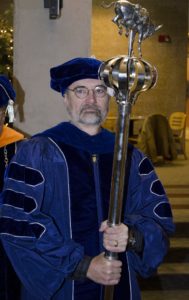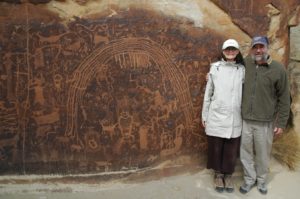2012 Distinguished Lecture Series: James McNeil
Beyond Leaps of Faith: The Physics of Snowboard Jumping
4 p.m., March 27, 2013 | Metals Hall, Green Center
Abstract
 The academic profession offers a privileged opportunity to serve society in ways large and small while being personally rewarding and socially beneficial. Retirement offers the additional luxury of time and freedom to explore novel intellectual challenges. Since retiring in 2008, I have applied my physics background to open problems in the diverse areas of archaeology and snowboard jump safety which will be the focus of this talk. Not only is snowboard jumping entertaining and the science simple, but it involves engagement with the larger society beyond academia.
The academic profession offers a privileged opportunity to serve society in ways large and small while being personally rewarding and socially beneficial. Retirement offers the additional luxury of time and freedom to explore novel intellectual challenges. Since retiring in 2008, I have applied my physics background to open problems in the diverse areas of archaeology and snowboard jump safety which will be the focus of this talk. Not only is snowboard jumping entertaining and the science simple, but it involves engagement with the larger society beyond academia.
In this talk I will describe my efforts to use basic physics to understand and improve the safety of winter terrain park jumps which are especially popular with snowboarders like my son, Brodie. Today these jumps are sculpted by skillful snowcat operators with little or no engineering considerations. Freestyle terrain jumping enjoys wide popularity and is aggressively promoted through professional events such as the Winter X-games. Today most ski resorts in the U.S. contain terrain parks that host jump features which range in size from a few feet to more than 80 feet in length. Not surprisingly, there have been several serious accidents at professional events as well as at public resorts. There is epidemiological evidence that terrain park jumps pose a significant risk to patrons for head and spinal cord injury. In addition there have been several catastrophic accidents resulting in paraplegia or death, often followed by high profile litigation which has raised public awareness of these risks.
My involvement in snowboard jumping began when Brodie would describe accidents to himself or others. Sometimes poor snow conditions, rider fatigue, or poor rider decisions were the principal factors leading to the accident, but more often than not accidents would occur on “bad” jumps for no apparent reason. It did not take long to understand that the “bad” aspects of such jumps could be understood from basic physics, and thus could in principle be controlled through an engineering design process. We co-authored a short paper on the dynamics of snowboard jumping which garnered some attention in the resort and associated legal communities. As an example for this talk I will focus on one important jump performance metric, the “equivalent fall height”, which quantifies the severity of an impact. I will describe how physics can assist jump designers in constructing jumps that control for this quantity. I will also relate my professional outreach efforts through professional and non profit organizations to convince a somewhat reluctant resort community to embrace engineering design in the construction of their jumps.
 Biography
Biography
 Jim McNeil received his bachelor’s degree from Lafayette College prior to embarking on his military service in 1970. Following the completion of his military service in 1974, he attended graduate school at the University of Maryland from which he received his Ph.D. in physics in 1979. Following two years as a postdoctoral researcher at the University of Pennsylvania, Jim served on the faculties of Villanova University and Drexel University before joining the faculty of the Colorado School of Mines in 1986.
Jim McNeil received his bachelor’s degree from Lafayette College prior to embarking on his military service in 1970. Following the completion of his military service in 1974, he attended graduate school at the University of Maryland from which he received his Ph.D. in physics in 1979. Following two years as a postdoctoral researcher at the University of Pennsylvania, Jim served on the faculties of Villanova University and Drexel University before joining the faculty of the Colorado School of Mines in 1986.
Jim’s early research interests focused on fundamental aspects of nuclear scattering theory. He pioneered the use of relativistic field-theoretic models of nucleons and mesons to describe both nuclear structure and scattering from the same fundamental starting point. From there his research evolved toward understanding non-perturbative field theories using renormalization group and lattice Monte Carlo simulations. This play of theory and numerical “experiment’’ became a common theme in much of Jim’s future research. Using the tools and understanding created by these investigations, he and his colleagues returned to nuclear scattering theory using renormalization group methods to derive improved effective potentials useful to three-body scattering calculations. These methods were found to be useful in describing Feshbach resonances in cold quantum gases as well.
Throughout his career Jim has taught a wide range of physics courses, from the introductory courses to graduate quantum field theory. Jim’s pedagogic approach was heavily influenced by Lev Vygotsky’s constructivist theories of learning which he learned about when his wife, Lynda, went through secondary education certification. In the mid-1990’s Jim received an NSF grant to undertake a major reform of the introductory electromagnetism course that incorporated many of Vygotsky’s ideas as well as included meaningful engineering design experiences. Many of those reforms survive in the new studio- based version of the course. He has received the Outstanding Physics Faculty award on numerous occasions and in 2010 he received the CSM Alumni Teaching Award.
Jim’s service to Mines included chairing several major committees, serving two terms as President of the Faculty Senate, and seven years as Head of the Physics Department. During his tenure as department head, the Engineering Physics program grew from about 70 to more than 270 majors becoming the largest Engineering Physics program in the nation. Over this same period, he guided the department through curricular reforms and personnel realignments that improved efficiency allowing reduced teaching loads for research active faculty which in turn facilitated the recruitment of high quality faculty and a doubling of funded research. Jim also helped initiate the CSM Sustainability initiative and the Nuclear Engineering graduate program. He chaired the McBride Reform Committee and the Energy Minor Committee going on to serve as the first Energy Minor coordinator.
In 2008, Jim started a transitional appointment and has turned his attention to applying physics to the diverse areas of archaeology and sports engineering. Specifically, Jim has explored the use of X-ray fluorescence to date Indian petroglyphs and built a portable XRF device. In a very different direction, Jim has authored several papers on the physics of winter terrain park jumping with the goal of building safer winter terrain park jumps. With his snowboarding son, Brodie, he co-founded the US Terrain Park Council, a non-profit entity whose mission is to outreach to the resort industry by providing a forum for adopting best practices in terrain park jump design. In addition to serving as chairman of the board of the USTPC, Jim serves as secretary of the Terrain Park Task Group of the ASTM’s Ski Safety Committee and is an instructor with the 2013 ISEA Winter School near Cortina, Italy. Jim is an avid blues guitar player. He and wife, Lynda, have two grown children and live in Boulder.